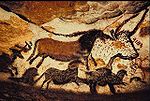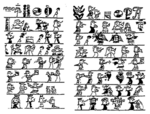Difference between revisions of "Written Language"
(preparing for further expansion) |
m (→Proto-Script) |
||
| Line 12: | Line 12: | ||
In some cultures, the symbols which once represented a concept would begin to also represent the sound that the word for that concept began with. This development allowed for a series of pictograms to convey a concept not easily drawn (like "love"), but for which the spoken language had a word for. Such cultures are said to write with an alphabet. | In some cultures, the symbols which once represented a concept would begin to also represent the sound that the word for that concept began with. This development allowed for a series of pictograms to convey a concept not easily drawn (like "love"), but for which the spoken language had a word for. Such cultures are said to write with an alphabet. | ||
| − | + | [[Image:Pictographs.png|150px|left|thumb|Pictographs.]] | |
In other cultures, abstract symbols were developed for verbs and for nouns not easily drawn. Such a culture is frequently said to write with hieroglyphs, although this word is generally not used for the Chinese system, although it fits this description. | In other cultures, abstract symbols were developed for verbs and for nouns not easily drawn. Such a culture is frequently said to write with hieroglyphs, although this word is generally not used for the Chinese system, although it fits this description. | ||
| − | Once a pictogram system developed to the point of being able to express all or most of the concepts which could be expressed through vocal language, it ceased to be a pictogram system and became a writing system. | + | Once a pictogram system developed to the point of being able to express all or most of the concepts which could be expressed through vocal language, it ceased to be a pictogram system and became a writing system. |
===Sumer=== | ===Sumer=== | ||
Revision as of 03:02, January 4, 2010
Writing is a way of putting down language in a symbolic form in some medium, usually with an alphabet but also possible with hieroglyphs or other characters. Unlike unrecorded speech, it is a form of communication that has a continuing nature in that it still exists or can be seen after it is completed.
Contents
History
The forerunners to writing were carved sticks or knotted cords that conveyed information. Prehistoric writing took the form of cave art such as found in France. The cultures that developed in Egypt and Sumeria both started with pictorial forms which led to Egyptian hieroglyphics and Sumerian cuneiform. The Hittites, Egyptians and Mesopotamians all devised symbols for specific sounds known as phonetic writing. During the 2nd millennium B.C., Semitic alphabets emerged allowing writing as know it. The Greeks and the Romans both copied these earlier alphabets.
Proto-Script
The forerunners to writing systems are universally pictograms. When early people wished to convey an idea in a permanent medium, they simply drew the concept. Examples of drawings by the first human beings can be found all over the world in the form of cave art. However, as certain symbols became more and more common, it became unnecessary to draw the concept precisely - broad strokes would convey the idea sufficiently.
This lead to development of pictographs, small, common pictures used to describe a series of ideas. For example, to write "The man ran to catch the mammoth," it sufficed to draw a man running with a spear next to a mammoth. However, such a system lacks the preciseness of modern writing.
In some cultures, the symbols which once represented a concept would begin to also represent the sound that the word for that concept began with. This development allowed for a series of pictograms to convey a concept not easily drawn (like "love"), but for which the spoken language had a word for. Such cultures are said to write with an alphabet.
In other cultures, abstract symbols were developed for verbs and for nouns not easily drawn. Such a culture is frequently said to write with hieroglyphs, although this word is generally not used for the Chinese system, although it fits this description.
Once a pictogram system developed to the point of being able to express all or most of the concepts which could be expressed through vocal language, it ceased to be a pictogram system and became a writing system.
Sumer
Egypt
Ancient Egyptian hieroglyphs form the basis for many modern writing systems.
Egyptian hieroglyphs were mostly forgotten by the Western world until Napoleons exploits in Egypt brought back many inscriptions. They were finally deciphered upon the discovery of the Rosetta stone, a single stone document which contained the same inscription in Greek, heiroglyphs, and cuneiform.
China
India
Mesoamerica
The oldest writing in the Western Hemisphere is from approximately 900 BC, and of Olmec origin.[1][2] However, the writing sample that has been found from this time appears to show a fully developed alphabetical system with 28 different symbols, so it is certain that writing had been discovered more than three thousand years ago in that region.
Mediterranean
References
- ↑ http://news.bbc.co.uk/2/hi/science/nature/5347080.stm
- ↑ http://www.sciencemag.org/cgi/content/abstract/313/5793/1610
Sources
The New American Desk Encyclopedia, Penguin Group, 1989

